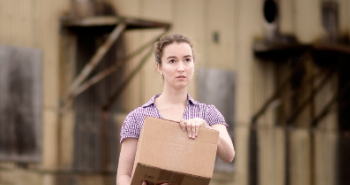Paz Pardo On Moving From NYC To Buenos Aires, Acting Vs Directing & Her Newest Work, “Perpetual Motion”


Paz Pardo is a prolific writer, actor, and director whose name you might recognize from her play Duct Tape Girl and Fetish Chick Conquer the World, performed in Park Slope living rooms in early 2013. With her one-woman show Perpetual Motion (which takes on “the ephemeral communities we create as we try to find ourselves in an unknown city” and employs “a combination of techniques stolen from sci-fi movies, experimental theater, and cooking blogs”) set to debut in our area at the end of the month, we spoke to Paz about her background in theater, international influences, a Fulbright grant gone delightfully awry, and more.
When did you first become interested in theatre? Were you a performer first, or did you keep behind the scenes for a while? Who (and/or which plays) do you count among your top inspirations?
My mother is a playwright, so I got into theater early (I was Lady Windermere’s fan for Halloween at age 6 — not Lady Windermere; her fan). I’ve always been a jack-of-all-trades, acting, directing, writing, and generally doing whatever needs doing. I love acting, but it’s the overall shaping of a performance that really draws me.
I’m a huge fan of work that uses humor to invite the audience in, but that also plays with form. Mike Iveson‘s Sorry Robot and Faye Driscoll‘s Thank You For Coming are two of the most inspiring pieces I’ve seen recently. Other influences include Cynthia Hopkins, Gob Squad, Grupo Krapp (from Buenos Aires) and Austin’s Rude Mechanicals. And, of course, there are my collaborators — if they didn’t inspire me, I wouldn’t be working with them!
How has traveling to Brooklyn, Buenos Aires, and beyond influenced your work — specifically Perpetual Motion, if applicable?
Perpetual Motion was a response to the experience of moving to Buenos Aires. Things had just started rolling for me in New York, and I up and moved to Argentina—which wasn’t the end of the world, my father is from Argentina so I spoke some Spanish, my godparents live down there — but I suddenly had the vocabulary of a nine-year-old and no collaborators. I’d always written with specific actors in mind, so when I was the only actor I knew I started writing for myself.
One thing I was struck by very early on was how few times most Argentines move, especially in Buenos Aires. In New York, everyone moves all the time. The play was kind of a way to try to explain to my Argentine friends what it feels like to move across the world.
Both Perpetual Motion and Duct Tape Girl and Fetish Chick Conquer the World are being/have been performed in living rooms. What do you think makes a home setting preferable to a more traditional stage?
I don’t think that living rooms are necessarily better than theaters for all plays, just for these two! Both Duct Tape Girl… and Perpetual Motion are built around audience participation, and I’ve found that people are much more comfortable with that outside of traditional theatrical venues (and with a drink or two in them).
Perpetual Motion, in particular, focuses on the alienation of moving and a particularly isolated extraterrestrial in Buenos Aires, and the performance counterbalances that narrative with the creation of a ephemeral community among the people in the room.
We’ve done the show in many different spaces — the basement of a mall, the lobby of a theater, a university classroom — and none of them foster a congenial atmosphere as much as a living room.
How have you found being directed by Enrique Lozano after having written and directed actors in Duct Tape Girl…? Is there a role (pardon the pun) you prefer to have — actor or director?
Puns are great! Writing Duct Tape Girl…, I knew I would direct it, but I knew I would need a director for Perpetual Motion as soon as I decided to write for myself. I can’t work in a room where I’m the only pair of eyes and ears; I get too caught up in my own neuroses.
At the same time, I often chafe at being an actor—there’s a selflessness that’s expected, especially in American theater, that I’m able to do but not good at balancing. There are times when I will accept decisions directors make but secretly hate them, and then later on I’ll feel frustrated and bitter and just have no fun. And my feeling is that if I’m not having any fun, I’m making bad theater. There are other people who are capable of creating really amazing work through suffering, but I suck at that.
So, finding a director who could both respect my vision of the piece and challenge me to make it better (both as a writer and actor) was a tall order. I got really lucky with Enrique; he’s a playwright and a director, and we have amazing work chemistry. Every time I have an idea, he’ll be like “oh, and also we should…” But he’ll also call me out when my performance is off the mark.
Our collaboration has really shaped the work; once we started rehearsing, Enrique pushed me to write nine more drafts of the piece, and it changed radically. He’s able to blend the roles of director and dramaturg in a way that’s really astonishing. Some of the most important ideas have been his. The audience sits in a circle with me during the show (in chairs, don’t worry), so it’s like a support group for compulsive movers; that was Enrique’s idea, and it allows my performance to be much freer and calmer than if I felt I were facing a panel of interrogators.
We’ve gone on to collaborate on two other projects since we met: La Ira de Kinski in Bogotá, and an untitled project in Buenos Aires slated for premiere this summer.
Did you ever end up writing that paper on Argentine theater and psychoanalysis after all?
No … don’t tell Fulbright? Actually, I wrote another article about the Argentine rehearsal and production model—and Perpetual Motion, as well, so I think we came out even.
Perpetual Motion, which according to its press release “promises sci-fi exposition, translation errors, and a brownie for everyone,” will be at Park Slope’s Quinoa Court Collective from Friday, January 30 to Monday, February 2. Tickets are available here.




